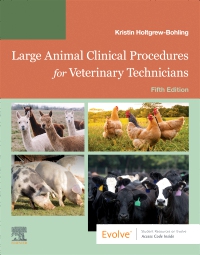
Large Animal Clinical Procedures for Veterinary Technicians - Elsevier eBook on VitalSource, 5th Edition
Elsevier eBook on VitalSource

Give your students the big picture on the vet tech’s role and responsibilities in large animal care! A practical, comprehensive guide, Large Animal Clinical Procedures for Veterinary Technicians, 5th Edition describes how to set up, assist, and follow through on medical procedures and treatment regimens for domestic livestock. The book begins with an overview of livestock handling, reproduction, and nutrition, along with the skills required in hospital management. Following are separate sections on horses, cattle, sheep and goats, llamas and alpacas, swine, and poultry, with each section including chapters examining husbandry, clinical and surgical procedures, and common diseases. It’s the ideal study tool for students preparing for the VTNE® and for everyday practice.
-
- NEW! Coverage of animal care includes care in small-scale and hobby farm settings, fear-free care, and IV catheter maintenance
- NEW! Updated information includes illegal drugs, remote delivery devices, nutrition and environmental enrichment for each species, carcass removal information, breeding soundness exam information for bulls, poisonous plants and other toxins, needle disposal and broken needle guidelines, sedation protocols, dehydration tables for calves, and more
- NEW! Updated images, case studies, step-by-step procedures, disease information, and terminology ensures students have the most current information
- NEW! Updated test bank questions and chapter quizzes on the Evolve website make study and review easier and increase retention of difficult subject matter
- Comprehensive large animal coverage is specifically tailored to the needs of veterinary technician students
- Coverage of the essential large animal-related tasks in the CVTEA Manual of Accreditation for Veterinary Technology Programs prepares students to pass the Veterinary Technology National Exam (VTNE®)
- Step-by-step procedures explain how and why a clinical procedure is performed, and the roles that vet techs fill in preparing for, assisting in, and following up the procedure
- "How-to" chapters within each species section examine husbandry, clinical procedures, surgical procedures, and common diseases — so veterinary technicians, acting under instructions of veterinarians, can plan and follow through on procedures and treatment regimens for large animals
- Evolve website includes quizzes, images, and reference materials for students, along with a test bank and PowerPoint® lecture slides for instructors
- Full-color photographs and line drawings show step-by-step procedures in areas such as restraint, bandaging, physical examination techniques, and diagnostic procedures
- Coverage of husbandry and breeds demonstrates how day-to-day housing and feeding affect the care of many large animal diseases, and also helps students learn to provide quality client education
- Livestock Industry section provides an overview of safety and handling, reproduction, and nutrition, so students can better understand the practices, procedures, and decisions in large animal veterinary medicine
- Learning features enhance critical thinking and decision making with case studies, clinical applications, key terms, chapter outlines, learning objectives, and Technician Notes
-
- NEW! Coverage of animal care includes care in small-scale and hobby farm settings, fear-free care, and IV catheter maintenance
- NEW! Updated information includes illegal drugs, remote delivery devices, nutrition and environmental enrichment for each species, carcass removal information, breeding soundness exam information for bulls, poisonous plants and other toxins, needle disposal and broken needle guidelines, sedation protocols, dehydration tables for calves, and more
- NEW! Updated images, case studies, step-by-step procedures, disease information, and terminology ensure that you have the most current information
- NEW! Updated test questions and chapter quizzes on the Evolve website make it easier to study, review, and remember difficult subject matter
-
PART 1: The Livestock Industry
1. The Importance of Livestock
2. Livestock Safety and Handling
3. Livestock Reproduction
4. Livestock Nutrition
PART 2: Large Animal Hospital Management
5. Daily Hospital Responsibilities
6. Admissions, Medical Records, and Physical Examinations
7. Diagnostic Imaging for Large Animals
PART 3: Horses in Veterinary Practice
8. Equine Husbandry
9. Equine Clinical Procedures
10. Equine Surgical Procedures
11. Common Equine Disease
PART 4: Cattle in Veterinary Practice
12. Bovine Husbandry
13. Bovine Clinical Procedures
14. Bovine Surgical Procedures
15. Common Bovine Diseases
PART 5: Sheep and Goats in Veterinary Practice
16. Ovine and Caprine Husbandry
17. Ovine and Caprine Clinical Procedures
18. Ovine and Caprine Surgical Procedures
19. Common Ovine and Caprine Diseases
PART 6: Llamas and Alpacas in Veterinary Practice
20. Camelid Husbandry
21. Camelid Clinical Procedures
22. Camelid Surgical Procedures
23. Common Camelid Diseases
PART 7: Swine in Veterinary Practice
24. Porcine Husbandry
25. Porcine Clinical Procedures
26. Porcine Surgical Procedures
27. Common Porcine Diseases
PART 8: Poultry in Veterinary Practice
28. Poultry Husbandry
29. Poultry Clinical Procedures
30. Poultry Surgical Procedures
31. Common Poultry Diseases


 as described in our
as described in our 